#tassili n’ajjer
Explore tagged Tumblr posts
Text
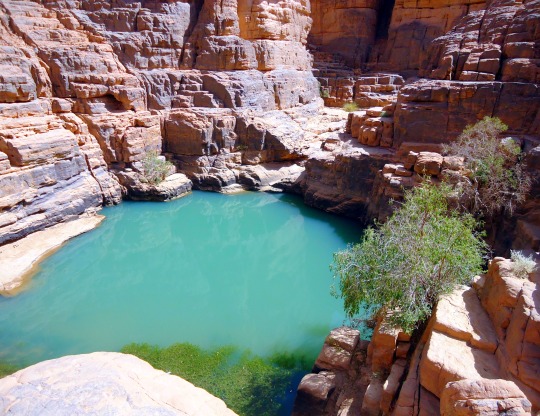
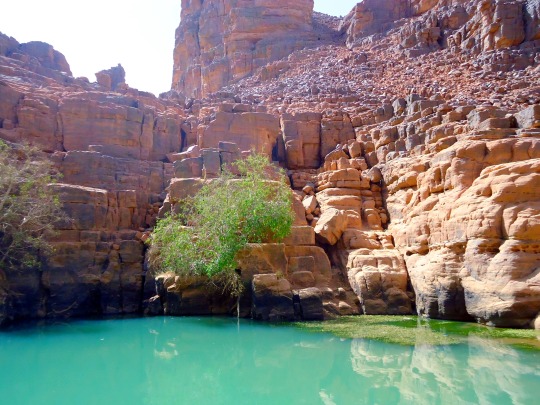

"THE GEOLOGICAL FORMATIONS ARE OF OUTSTANDING SCENIC INTEREST..."
PIC(S) INFO: Spotlight on Gueltade Tikoubaouine, Tassili n’Ajjer, Algeria, North Africa, a UNESCO World Heritage site. 📸: “Extraanis,” c. 2015 (via Wikimedia).
MINI-OVERVIEW: “Located in a strange lunar landscape of great geological interest, this site has one of the most important groupings of prehistoric cave art in the world. More than 15,000 drawings and engravings record the climatic changes, the animal migrations and the evolution of human life on the edge of the Sahara from 6000 BC to the first centuries of the present era. The geological formations are of outstanding scenic interest, with eroded sandstones forming "forests of rock.”
– UNESCO WORLD HERITAGE CONVENTION
Source: https://commons.m.wikimedia.org/wiki/File:Canyon_de_Tikoubaouine.JPG (3x).
#UNESCO World Heritage Site#UNESCO#Nature#Algeria#Photography#Geology#North Africa#Rock Formations#Africa#African Oasis#Geological Site#UNESCO World Heritage#North African#North African Landscapes#Landscapes#Geological#Rocks#Forests of Rock#Gueltade Tikoubaouine#Tassili n’Ajjer#Nature photography#World Heritage Site
20 notes
·
View notes
Text

Cornrows are historically a beautiful result of sisterhood and shows how we have always been connected by are femininity!
🚺💜🚺
#history#cornrows#traditional hairstyles#canerows#tassili n’ajjer#african history#algeria#sisterhood#horn of africa#ancient#womens history#hairstyles#black beauty#coquette#traditional culture#black culture#girly girl#black femininity#ancient history#black excellence#african women#femininity#black coquette#braids#black hair#soft girl#feminine history#nickys facts
5 notes
·
View notes
Text

Tassili n’Ajjer, Algeria
16,000 years old
16 notes
·
View notes
Text

8000 year old cave painting in Tassili n'Ajjer, Algeria depicting a shaman during a psychedelic mushroom use(5800 BC)
Cave art in Tassili n’Ajjer SE Algeria shows the oldest known petroglyphs of psychoactive mushrooms, specifically Psilocybe.
The paintings show people holding objects that look like mushrooms and some have mushrooms growing from their bodies.
76 notes
·
View notes
Text
''قافـــلـــة الايـــموهاغ '' الـــــطـــــوارق
CARAVAN OF IMOHAGH - La caravane des Imoûhagh Touareg 🐪🐪🐪🐪🐪🐪
الـــــــجزائـــــــــــــر_ Algeria
منذ اقدم العصور جاب الطوارق الايموهاغ الصحراء بقوافلهم فاحيوا الواحات و المخيمات و المجتمعات السكانية و قامو بتامين تبادل تجاري و ثقافي, حيث كان هناك قوافل تسافر لعدة اشهروكانت مكونة في بعض المرات مثل قافلة الملح " الزاي " بما يزيد عن الالف جمل .
Depuis la nuit des Temps, les TOUAREGS ont sillonné le Sahara en tous sens avec leurs caravanes, faisant vivre les oasis, les campements, les centres de vie, assurant les échanges commerciaux et culturels. Les caravanes partaient pour plusieurs mois et certaines étaient constituées, comme l’Azalaï la caravane du sel, de plus de 1000 dromadaires.
Since the dawn of Time, theTUAREG have crossed the Sahara in all directions with their caravans and live oasis, encampments, living centers, providing the commercial and cultural exchanges.
The caravan left for several months and were incorporated, as the caravan Azalaï salt, more than 1,000 camels.
La Grande Caravane de l’Ahaggar au Tassili N’Ajjer
C’est la piste des rezzou d’autrefois que vous suivez. De Tamanrasset à Djanet, 700 km à dos de dromadaire. Sur votre parcours, les oueds et campements de l’Est de l’Ahaggar, de vieilles montagnes volcaniques, les ténérés d’Amadghor et du Tafessasset, les grandes dunes de l’erg Admer, les falaises du tassili N’Ajjer
The Big Caravan
From Ahaggar to Tassili of N'Ajjer
This is the track of past raids that you follow. Tamanrasset to Djanet, 700 km camel. On your journey, wadis and settlements in eastern Ahaggar, ancient volcanic mountains, Ténéré of Amadghor Tafessasset, the large dunes of Erg Admer, cliffs of Tassili N'Ajjer
21jours & 22 nuits / 21 days & 22 nights
Caravane de l’Ahaggar
Au fil des oueds qui serpentent comme des veines entre les collines de l’Est de l’Ahaggar vous découvrez des campements de zéribas, des jardins sahariens, des gravures rupestres, des oiseaux, vieux volcans.
Ce voyage peut se faire à deux ou à plus que deux personnes
Caravan of Ahaggar
Over the wadis that wind like veins in the hills east of the Ahaggar you find camps of zéribas (huts), Saharan gardens, rupestral engravings, birds, old volcanoes.
🐪🐪🐪🐪🐪🐪🐪🐪🐪🐪🐪🐪🐪🐪🐪🐪🐪🐪


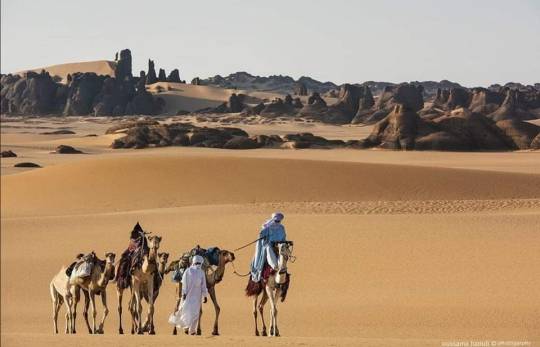
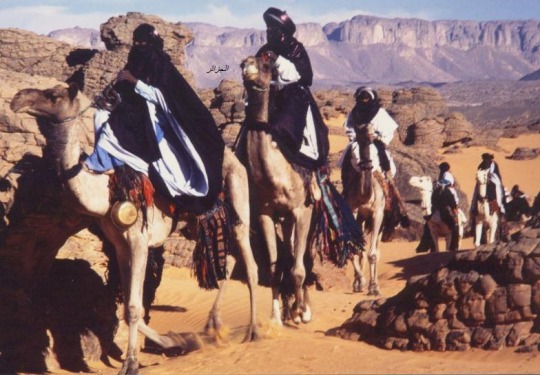
21 notes
·
View notes
Text

Tassili n’Ajjer, Algérie.
1 note
·
View note
Text
Ancient Art of Tassili n’Ajjer: 12,000-Year-Old Window into Sahara’s Past
Hidden in the vast Sahara Desert, the cave paintings of Tassili n’Ajjer are among the oldest and most intriguing art forms in human history. …Ancient Art of Tassili n’Ajjer: 12,000-Year-Old Window into Sahara’s Past

View On WordPress
0 notes
Text
Tassili n’Ajjer, Algeria: A New Year Under Ancient Skies
Excited to plan your next adventure? We’ve curated a list of the world’s most mesmerizing destinations just for you. Whether you’re drawn to vibrant cultural landmarks or breathtaking natural landscapes, these places guarantee memories that last a lifetime. Explore the highlights below, and let’s create your perfect getaway!

1. Location Overview
Tassili n’Ajjer, a UNESCO World Heritage Site in Algeria, is a vast plateau known for its stunning desert landscapes and prehistoric rock art. This unique destination offers an adventurous and spiritual New Year experience.

Click here to start your adventure.
2. Why Visit Tassili n’Ajjer
Spectacular Landscapes: Discover surreal sandstone formations, hidden canyons, and vast dunes.
Cultural Significance: View ancient rock art dating back thousands of years.
Starlit New Year Celebration: Enjoy the ultimate desert serenity under a canopy of stars.

3. What Can We Do in Tassili n’Ajjer
Camp in the desert and welcome the New Year around a traditional bonfire.
Explore prehistoric rock carvings and paintings on guided tours.
Trek through rugged terrain to discover hidden oases.
Capture stunning desert sunsets and landscapes on a photography tour.

4. How to Plan Our Visit to Tassili n’Ajjer
Getting There: Fly to Djanet Inedbirene Airport, the gateway to Tassili n’Ajjer.
Where to Stay: Opt for eco-friendly camps or traditional desert accommodations.
Local Tips: Travel with an experienced guide to fully appreciate the region’s history and navigate its terrain.
Call to Action
Celebrate a New Year unlike any other in Tassili n’Ajjer’s captivating desert. Let us take care of every detail. Click here to start your adventure.
0 notes
Photo

Rock formations and sand dunes in the Sahara, Tassili n’Ajjer, Algeria (© Airpano/Amazing Aerial Agency)
1 note
·
View note
Text
Best tours in mauritania,
Best tours in mauritania,
Mauritania, a country of stunning landscapes and rich cultural heritage, offers travelers a unique blend of desert adventures, historical exploration, and vibrant local traditions. From the majestic sands of the Sahara to the bustling markets of its capital, Nouakchott, Mauritania is a hidden gem for those seeking an off-the-beaten-path travel experience. Here’s a guide to some of the best tours to make the most of your visit to this fascinating country.
Sahara Desert Adventure Chinguetti and the Ancient Trade Routes A tour of Chinguetti, one of the oldest and most significant oases in the Sahara, is a must for any traveler. This ancient city, once a major stop on the trans-Saharan trade routes, is known for its well-preserved medieval architecture and historic manuscripts. Tours often include camel rides through the vast dunes, providing a classic desert experience. Don’t miss the opportunity to visit the old mosques and libraries, where ancient Arabic texts are still preserved.
Ouadane and the Desert Vistas For a more remote desert experience, head to Ouadane, a UNESCO World Heritage Site. This ancient city is a treasure trove of historical ruins set against breathtaking desert landscapes. Guided tours will lead you through the remnants of old fortifications, ancient houses, and the stunning sand dunes that surround the area.
Nouakchott City Tour The Heart of Mauritania Nouakchott, the bustling capital, offers a vibrant contrast to the serene desert landscapes. Explore the lively markets, where you can find traditional Mauritanian crafts, fabrics, and spices. The Port of Nouakchott is also worth a visit, offering a glimpse into the local fishing industry and the opportunity to enjoy fresh seafood. Key sites include the Nouakchott Grand Mosque and the National Museum, where you can learn about Mauritania’s rich cultural heritage.
Local Cultural Experiences Immerse yourself in Mauritanian culture with a guided tour that includes traditional music and dance performances, as well as visits to local artisans. Experience the vibrant colors and intricate designs of Mauritanian textiles and crafts, and perhaps even participate in a traditional cooking class to learn how to prepare local dishes.
Banc d'Arguin National Park A UNESCO World Heritage Site Banc d'Arguin National Park is a paradise for nature lovers and bird watchers. This vast wetland area is home to a diverse range of wildlife, including thousands of migratory birds. Boat tours are available to explore the park’s lagoon and coastal areas, where you might spot dolphins and sea turtles. The park’s unique ecosystem provides a stunning contrast to the surrounding desert landscapes.
Fishing Villages and Eco-Tourism Combine your visit to the park with a tour of the nearby fishing villages, where you can learn about traditional fishing methods and enjoy fresh seafood. Eco-tourism initiatives in the area offer sustainable ways to experience the park’s natural beauty while supporting local communities.
Atar and the Adrar Region Exploring Atar The city of Atar, the gateway to the Adrar region, offers a mix of cultural and natural attractions. Explore the traditional architecture and vibrant markets, and take day trips into the surrounding Adrar mountains. The region is known for its dramatic landscapes, including ancient rock formations and beautiful oases.
The Ancient Rock Art One of the highlights of the Adrar region is its ancient rock art. Guided tours will take you to sites featuring prehistoric petroglyphs that provide insight into the region’s early inhabitants. The art, depicting animals and human figures, is a fascinating window into the past.
Tassili n’Ajjer National Park The Bordering Wonders While technically located in Algeria, Tassili n’Ajjer National Park is accessible from Mauritania and offers a continuation of the rich desert experience. This UNESCO World Heritage Site is renowned for its prehistoric rock art, stunning geological formations, and unique wildlife. Guided tours can include trekking through the park’s dramatic landscapes and viewing its remarkable ancient cave paintings.
Tips for Traveling in Mauritania Travel with a Guide: Many areas, especially the desert and remote regions, are best explored with an experienced local guide who can provide insight into the culture and ensure your safety. Respect Local Customs: Mauritania is a predominantly Muslim country, so dress modestly and be mindful of local customs and traditions. Prepare for the Weather: The desert climate can be extreme, with very hot days and chilly nights. Dress in layers and stay hydrated. Mauritania is a land of contrasts, where ancient traditions meet stunning natural beauty. Whether you're exploring the depths of the Sahara, immersing yourself in local culture, or marveling at the natural wonders, these tours will help you uncover the many facets of this unique and captivating country.
0 notes
Text
0 notes
Text
Mixed Media | The Significance of Paleolithic Art
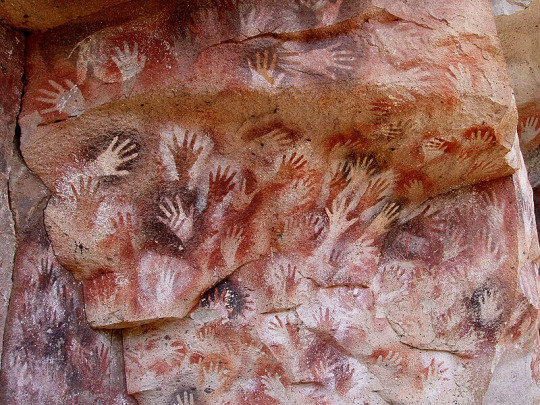
Red Hand Stencil - Maltravieso Cave, Cáceres, Spain
Cave paintings are among the earliest forms of art, expression, and human communication, offering us a profound and deeply symbolic link to our distant past. These artworks often depicted a sacred rituals, communication between people, and the recounting of events and life in Paleolithic times. Created using rudimentary tools and natural pigments, these artworks represent a multitude of themes — from depictions of the natural world and celestial bodies, to complex scenes of hunting, rituals, and what is believed to be early spiritual or religious experiences.
This art represents more than just a record of human history. It also stands as a symbol of early humanity's emergence of complex cognizance. This marked the turning point of when the collective consciousness of humankind began to develop abstract thinking, symbolic behavior, and the capacity for cultural transmission. The purpose and significance of these ancient works of art are manifold. They were not just mere decorations or doodles of idle minds, but rather, they held deep meanings for their creators.
African cave paintings provide a captivating glimpse into the rich tapestry of human history. These remarkable works of art, dispersed across the vast continent, stand as silent witnesses to the lives, beliefs, and creativity of our ancestors, presenting an intriguing visual record of humanity’s cultural evolution. The significance of African cave paintings in human history is immense. Since Africa is widely believed to be the birthplace of humanity, these paintings which relfected the cognitive and cultural advancements of early humans were often regarded as some of the earliest artistic expressions of Homo sapiens. The cave paintings span a vast timeframe, from the Upper Paleolithic period through to the recent prehistoric era.
The Upper Palaeolithic period, dating from approximately 40,000 to 10,000 BCE, boasts some of the earliest known rock art, were characterised by depictions of large animals and abstract symbols. Following periods saw the introduction of human figures, intricate patterns, and more complex narratives, indicative of the societies’ evolving artistic skills and cognitive abilities. As the birthplace of humanity, African cave art is extremely important in understanding the prehistorical records of our species. Their artistic legacy profoundly influenced the artistic traditions of subsequent cultures, both within Africa and beyond.
Cave Art in North Africa

Tassili n’Ajjer National Park, Algeria
Home to over 15,000 drawings and engravings that trace back as far as 6000 BCE, Tassili n’Ajjer is renowned for its rock art, which vividly captures the environmental changes that occurred in the area over thousands of years.

These artworks are characteristically executed in a variety of styles and techniques, often depicting an array of symbols, animals, and human figures. The depiction of animals in this region specifically indicates a society that was closely intertwined with nature and reliant on hunting and gathering, with the diverse collection of symbols and figures suggesting an evolving artistic tradition and complex symbolic language.

Wadi Mathendous, Libya
Wadi Mathendous is a rock art site located in southwestern Libya, which houses a treasure trove of prehistoric art in the heart of the Sahara. It is famed for its distinctive paintings and carvings, primarily etched onto the darkened surfaces of weathered sandstone outcrops. These petroglyphs portray a varied range of subjects, from wildlife and human figures to symbolic patterns and scenes of daily life.
A significant influence of these ancient art forms is seen in contemporary art and culture. The aesthetics, themes, and techniques of these paintings have been mirrored and adapted in modern artistic endeavours, whether consciously or subconsciously. From Picasso’s fascination with African art to the use of cave painting motifs in graphic design and digital media, the echoes of these early creative expressions continue to resonate in our visual culture.
0 notes
Text

The Museu de Arte de São Paulo (MASP) stands out in this aerial view of São Paulo, Brazil 🇧🇷. The powerhouse art museum is completing an ambitious expansion project due to open in 2024. Photograph By Mavinho Acoroni

Stars glitter above Naveta des Tudons, Spain 🇪🇸, Menorca’s most famous burial monument. It’s just one of over a thousand sites on the island built by the Talayotic culture in the Iron Age. Photograph By Sebastián Iturralde

Sandstone formations, dunes, and ancient rock art fill Tassili n’Ajjer National Park, a UNESCO World Heritage site in the Algerian Sahara, Algeria 🇩🇿. Photograph By Matjaz Krivic

A juvenile whale shark glides over Ningaloo Reef, in Western Australia 🇦🇺, where these gentle giants congregate annually. Photograph By Kiliii Yüyan, National Geographic

The majestic Magdalena River is at its narrowest near San Agustín, Colombia 🇨🇴. But new small-ship cruises take in the landscapes, birdlife, and villages along the vital waterway’s wider stretches. Photograph By Florence Goupil, National Geographic

Brown bears graze in Hallo Bay, in Alaska’s Katmai National Park, United States 🇺🇸. The bay‘s grassy meadows are a popular spot for bear-watching tours from June through September. Photograph By AcaciaJohnson, National Geographic

Guide Hamprey Mweterwa (center on white horse) leads a group on a safari in Kenya’s 🇰🇪 Borana Conservancy. Visitors to Borana might encounter zebras, leopards, impalas, elephants, and the area’s population of 200 rhinos—a relative of the horse. Photograph By Nichole Sobecki, National Geographic
0 notes
Text
Il deserto del Sahara un tempo era una verde savana: Una ricerca spiega il perché
L’altopiano del Tassili N’Ajjer in Algeria è il più grande parco nazionale dell’Africa. Tra le sue vaste formazioni di arenaria si trova forse il più grande museo d’arte del mondo. Vi sono esposte oltre 15.000 incisioni e dipinti, alcuni dei quali risalenti a 11.000 anni fa secondo le tecniche di datazione scientifica, che rappresentano una testimonianza etnologica e climatologica unica della…

View On WordPress
0 notes
Text
A tuareg near a small oasis in Tassili N’Ajjer, Algeria

0 notes
Text
A tuareg near a small oasis in Tassili N’Ajjer, Algeria

0 notes